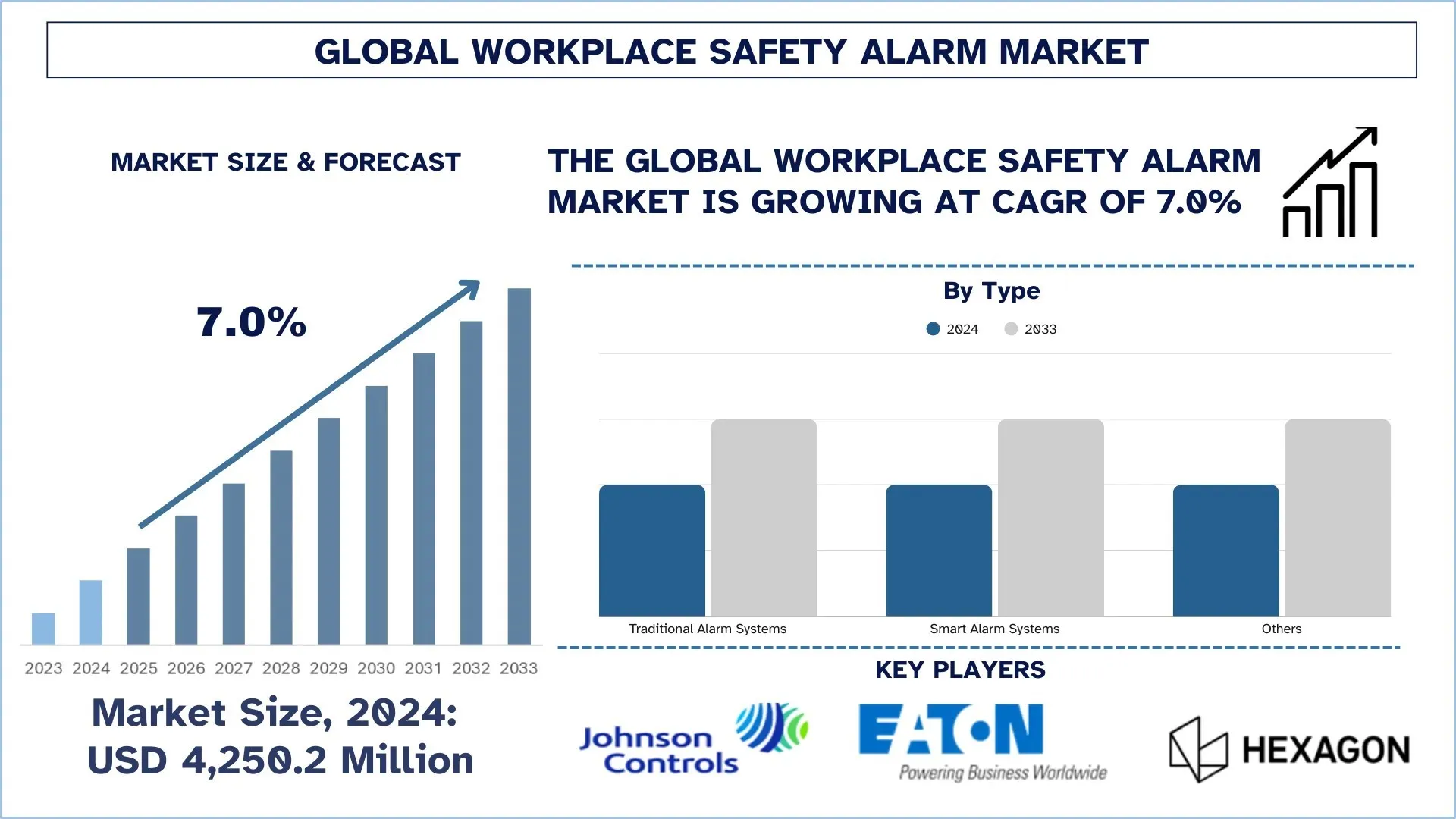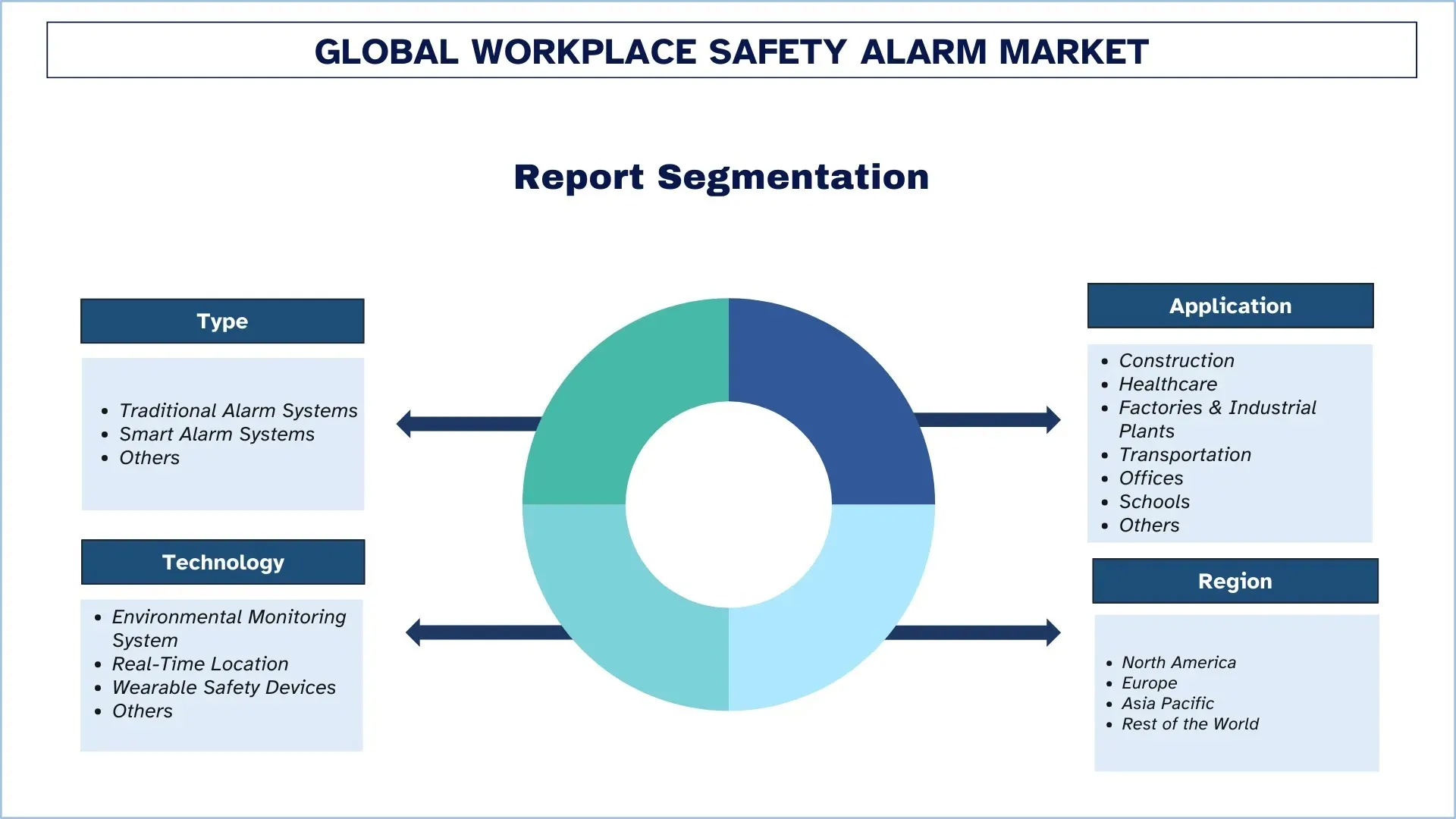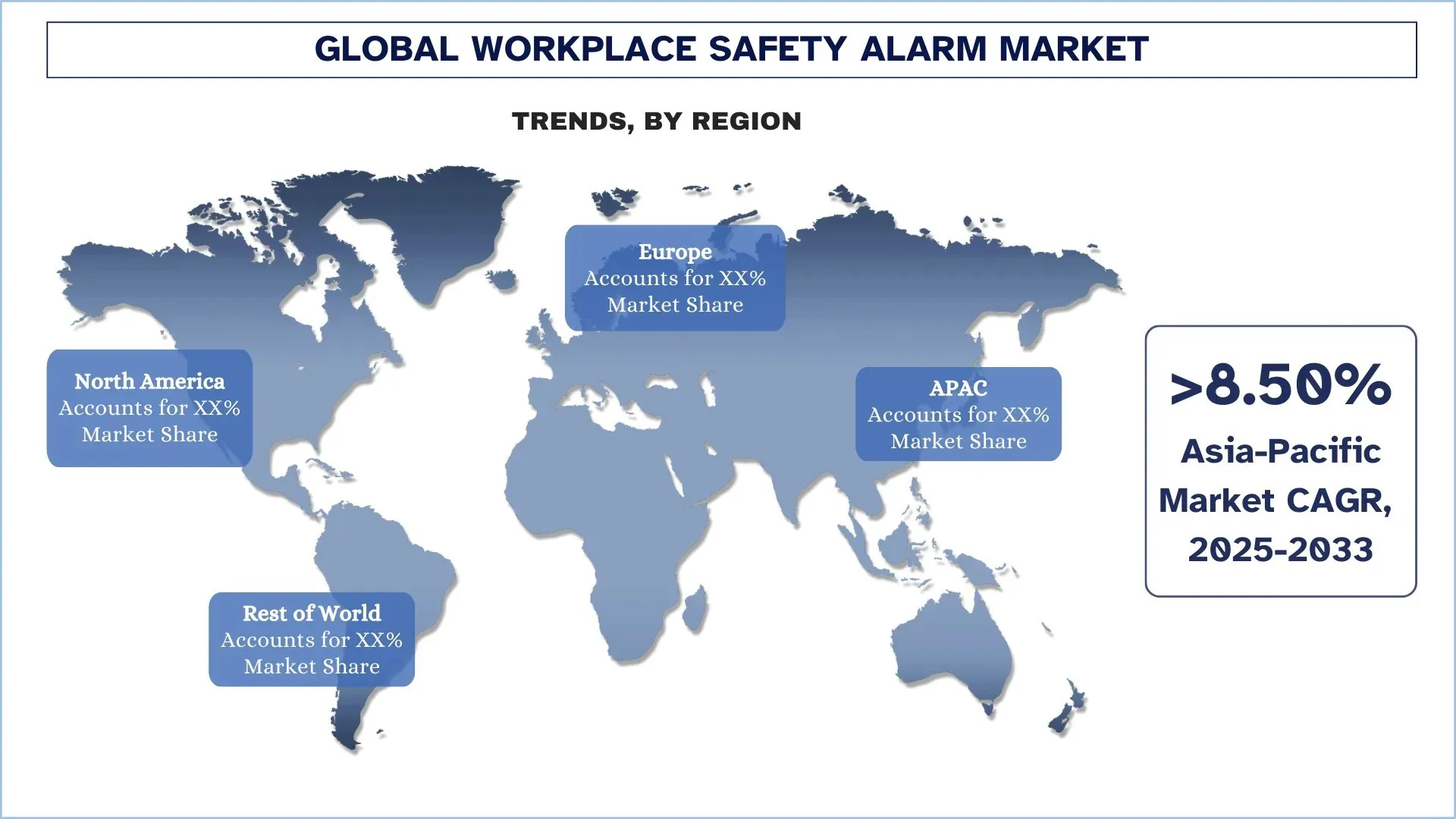- Home
- About Us
- Industry
- Services
- Reading
- Contact Us
Workplace Safety Alarm Market: Current Analysis and Forecast (2025-2033)
Emphasis on Type (Traditional Alarm Systems, Smart Alarm Systems, and Others); Technology (Environmental Monitoring Systems, Real-Time Location, Wearable Safety Devices, and Others); Application (Construction, Healthcare, Factories & Industrial Plants, Transportation, Offices, Offices, Schools, and Others); and Region/Country

Global Workplace Safety Alarm Market Size & Forecast
The Global Workplace Safety Alarm Market was valued at USD 4,250.2 million in 2024 and is expected to grow at a strong CAGR of around 7.0% during the forecast period (2025-2033), driven by increasing workplace safety needs and technological advancements.
Workplace Safety Alarm Market Analysis
Workplace safety alarms are systems and devices that detect threats, provide alerts to employees, and ensure worker safety within multiple industries. These solutions are available in on-premises and cloud-based formats, with technologies including environmental monitoring, real-time location tracking, incident & emergency management systems, and wearable safety devices. Furthermore, they are used in various sectors such as factories and industrial plants, construction sites, healthcare facilities, transportation, offices, and schools. Workplace safety alarms are implemented in small and large enterprises due to strict regulatory compliance, increasing technological adoption, and operational safety. These systems play a vital role in preventing accidents, ensuring compliance, and protecting the workforce's well-being globally.
Rising industrialization, urbanization, and infrastructure development are creating higher safety risks, encouraging companies to utilize advanced alarm systems. Strong government regulations are pushing organizations to integrate the use of safety alarms. Moreover, integration of advanced technologies such as IoT devices and real-time monitoring systems within the existing system has improved the safety alarm threat detection and emergency response capabilities, driving market growth.
Global Workplace Safety Alarm Market Trends
This section discusses the key market trends that are influencing the various segments of the global workplace safety alarm market, as found by our team of research experts.
Integration of AI in Safety Alarms
The integration of Artificial Intelligence (AI) in safety alarms is one of the emerging trends in the workplace safety alarm market. AI-based safety alarms collect data from sensors and wearable devices and analyse it to detect potential threats such as gas leaks, fire risks, or worker distress. These features help in reducing the risk of accidents in the workplace. Furthermore, the use of machine learning algorithms helps in improving accident prediction, providing preventive measures rather than reactive responses. By reducing false alerts and providing faster and more reliable decision-making, AI has improved alarm accuracy. Moreover, AI-generated analytics reports provide valuable insights, improving compliance reports and safety measures. The growing use of AI in safety alarms is improving productivity in the workplace, reducing risks, and accelerating the adoption of smart safety alarms globally.
Workplace Safety Alarm Industry Segmentation
This section provides an analysis of the key trends in each segment of the global workplace safety alarm market report, along with forecasts at the global, regional, and country levels for 2025-2033.
The Traditional Alarm Systems Segment Dominates the Global Workplace Safety Alarm Market
Based on the type category, the market is further segmented into traditional alarm systems, smart alarm systems, and others. Among these, the traditional alarm system has the highest market share in the workplace safety alarm market due to its low cost, well-established infrastructure, and strong regulatory compliance. Due to these features, companies preferred using traditional systems. Moreover, their strong performance, easy setup, and minimal reliance on network connectivity are also driving their growth. However, the smart alarm system segment is showing the fastest growth. This is due to technological advancements such as the integration of AI, IoT devices, cloud computing, and real-time monitoring in traditional alarms. Thereby increasingly attracting businesses and driving the growth of the market.
The Real-Time Monitoring Segment Dominates the Global Workplace Safety Alarm Market.
Based on technology, the market is categorized into environmental monitoring systems, real-time location, wearable safety devices, and others. Among these, the real-time monitoring segment dominated the market due to increasing demand for asset tracking, people tracking, and detecting nearby hazards. However, the environmental monitoring system is showing the fastest growth. This is due to growing regulatory mandates, rising awareness of environmental hazards, and the need for stronger emergency response capabilities.

North America holds the largest market share in the global workplace safety alarm market
North America has been the market leader due to early adoption of technology, strong regulatory mandates, and increasing safety concerns among workers. Organisations of various sectors, such as oil & gas, construction, manufacturing, and healthcare, are investing heavily in safety products to ensure a safer workplace. Increasing safety concerns among workers and regions with strong occupational health and safety cultures are boosting the adoption of smart alarms. Additionally, continuous product development, innovation, and the presence of major safety solution providers help North America to lead the global market. For instance, in 2025, Ring & Kiddle launched smart smoke and carbon monoxide alarms that utilise Wi-Fi technology and send an alert on smartphones whenever the alarm triggers.
U.S. held a Dominant share of the North America Workplace Safety Alarm Market in 2024
The U.S. dominated the workplace safety alarm market due to early adoption of advanced technologies and strong regulatory standards for the workplace set by organizations such as OSHA, which encourage strong workplace safety standards. Furthermore, increasing investment and mergers & acquisitions in the country by various industries, such as manufacturing, oil & gas, construction, and healthcare, to ensure a safer environment, is driving the growth of the market. For instance, in May 2025, Feit Electronics acquired the brand and alarm segment of Universal Security Instrument, expanding its product portfolio in the safety equipment category. Moreover, the presence of major safety technology providers and continuous product innovations has made the U.S. lead the market. Increasing worker awareness for occupational safety, combined with a culture of prioritising health and safety, further supports the country’s market leadership.

Workplace Safety Alarm Industry Competitive Landscape
The global workplace safety alarm market is competitive, with several global and international market players. The key players are adopting different growth strategies to enhance their market presence, such as partnerships, agreements, collaborations, geographical expansions, and mergers and acquisitions.
Top Workplace Safety Alarm Market Companies
Some major players running in the market include Johnson Controls International plc, Eaton, Hexagon AB (publ), Honeywell International Inc., Gas Alarm Systems, Ravelfire, Grace Industries, Inc., SolusGuard, SRJ Group, and Relay Inc.
Recent Developments in the Workplace Safety Alarm Market
In July 2025, Honeywell announced the acquisition of Li-Ion Tamer, a lithium-ion battery off-gas detector provider. With this acquisition, Honeywell aims to improve its fire detection alarm system product portfolio.
In June 2025, Samsara launched its AI-powered wearable devices for workers. The device offers features such as one-click emergency alert, fall detection, and threat alerts. This product launch is expected to enhance the company’s product portfolio and improve worker safety.
Global Workplace Safety Alarm Market Report Coverage
Report Attribute | Details |
Base year | 2024 |
Forecast period | 2025-2033 |
Growth momentum | Accelerate at a CAGR of 7.0% |
Market size 2024 | USD 4,250.2 million |
Regional analysis | North America, Europe, APAC, Rest of the World |
Major contributing region | The Asia-Pacific region is expected to dominate the market during the forecast period. |
Key countries covered | U.S., Canada, Germany, U.K., Spain, Italy, France, China, Japan, India, and South Korea. |
Companies profiled | Johnson Controls International plc, Eaton, Hexagon AB (publ), Honeywell International Inc., Gas Alarm Systems, Ravelfire, Grace Industries, Inc., SolusGuard, SRJ Group, and Relay Inc. |
Report Scope | Market Trends, Drivers, and Restraints; Revenue Estimation and Forecast; Segmentation Analysis; Demand and Supply Side Analysis; Competitive Landscape; Company Profiling |
Segments Covered | By Type, By Technology, By Application, and By Region/Country |
Reasons to Buy the Workplace Safety Alarm Market Report:
The study includes market sizing and forecasting analysis confirmed by authenticated key industry experts.
The report briefly reviews overall industry performance at a glance.
The report covers an in-depth analysis of prominent industry peers, primarily focusing on key business financials, type portfolios, expansion strategies, and recent developments.
Detailed examination of drivers, restraints, key trends, and opportunities prevailing in the industry.
The study comprehensively covers the market across different segments.
Deep dive regional level analysis of the industry.
Customization Options:
The global workplace safety alarm market can further be customized as per the requirements or any other market segment. Besides this, UnivDatos understands that you may have your own business needs; hence, feel free to contact us to get a report that completely suits your requirements.
Table of Content
Research Methodology for the Global Workplace Safety Alarm Market Analysis (2023-2033)
We analyzed the historical market, estimated the current market, and forecasted the future market of the global workplace safety alarm market to assess its application in major regions worldwide. We conducted exhaustive secondary research to gather historical market data and estimate the current market size. To validate these insights, we carefully reviewed numerous findings and assumptions. Additionally, we conducted in-depth primary interviews with industry experts across the workplace safety alarm value chain. After validating market figures through these interviews, we used both top-down and bottom-up approaches to forecast the overall market size. We then employed market breakdown and data triangulation methods to estimate and analyze the market size of industry segments and sub-segments.
Market Engineering
We employed the data triangulation technique to finalize the overall market estimation and derive precise statistical numbers for each segment and sub-segment of the global workplace safety alarm market. We split the data into several segments and sub-segments by analyzing various parameters and trends, including type, technology, application, and regions within the global workplace safety alarm market.
The Main Objective of the Global Workplace Safety Alarm Market Study
The study identifies current and future trends in the global workplace safety alarm market, providing strategic insights for investors. It highlights regional market attractiveness, enabling industry participants to tap into untapped markets and gain a first-mover advantage. Other quantitative goals of the studies include:
Market Size Analysis: Assess the current and forecast market size of the global workplace safety alarm market and its segments in terms of value (USD).
Workplace Safety Alarm Market Segmentation: Segments in the study include areas of type, technology, application, and region.
Regulatory Framework & Value Chain Analysis: Examine the regulatory framework, value chain, customer behavior, and competitive landscape of the workplace safety alarm industry.
Regional Analysis: Conduct a detailed regional analysis for key areas such as Asia Pacific, Europe, North America, and the Rest of the World.
Company Profiles & Growth Strategies: Company profiles of the workplace safety alarm market and the growth strategies adopted by the market players to sustain the fast-growing market.
Frequently Asked Questions FAQs
Q1: What is the global workplace safety alarm market’s current market size and growth potential?
As of 2024, the global workplace safety alarm market is valued at USD 4,250.2 million and is projected to grow at an impressive CAGR of 7.0% from 2025 to 2033, driven by increasing workplace safety needs and technological advancements.
Q2: Which segment has the largest share of the global workplace safety alarm market by type category?
The traditional alarm systems segment holds the largest share of the global workplace safety alarm market, due to the widespread deployment of conventional, physical alarm systems across workplaces.
Q3: What are the driving factors for the growth of the global workplace safety alarm market?
Top growth drivers of the workplace safety alarm market include:
• Technological advancements in safety alarm systems
• Stricter workplace safety regulations worldwide
• Rising incidents of workplace accidents and security threats
Q4: What are the emerging technologies and trends in the global workplace safety alarm market?
Emerging trends in the workplace safety alarm market include:
• Integration of AI and smart analytics for predictive safety alerts
• Cloud-based safety alarm systems for real-time monitoring and remote management.
Q5: What are the key challenges in the global workplace safety alarm market?
Key challenges in the workplace safety alarm market include:
• High initial costs of smart and advanced safety alarm systems
• Integration issues with the existing workplace safety infrastructure
Q6: Which region dominates the global workplace safety alarm market?
North America dominates the global workplace safety alarm market, driven by advanced workplace safety standards and high adoption of smart alarm technologies.
Q7: Who are the key competitors in the global workplace safety alarm market?
Top players in the Workplace safety alarm industry include:
• Johnson Controls International plc
• Eaton
• Hexagon AB (publ)
• Honeywell International Inc.
• Gas Alarm Systems
• Ravelfire
• Grace Industries, Inc.
• SolusGuard
• SRJ Group
• Relay Inc.
Q8: What are the investment opportunities in the global workplace safety alarm market?
The workplace safety alarm market presents significant investment opportunities, particularly in smart alarm systems, AI-integrated solutions, and cloud-based monitoring platforms. Rapid market growth and increasing regulatory compliance make this segment an attractive investment opportunity for investors and technology providers.
Q9: How is the competitive landscape shaping the workplace safety alarm market?
The market is highly competitive with major players focusing on mergers, acquisitions, and strategic partnerships to expand their footprint. Innovation in AI and IoT-enabled safety alarms is a key differentiator among top companies.
Related Reports
Customers who bought this item also bought








